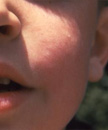Fifth Disease (Erythema Infectiosum)
Parvovirus B 19 Infection
- Fifth disease is a viral illness with 3 stages
- Caused by Human parvovirus B19
- Occurs in late winter & early spring
- Highest incidence seen in children ages 5 to 15 years
- Transmitted by droplets
- Incubation period is 4-14 days
- Contagious prior to rash. Isolation not necessary one rash appearance
- Fifth disease during pregnancy can result in spontaneous abortion & stillbirth
- Fetal abnormalities have not been associated with B19 viral infections
- Immunity happens after one attack
- Rash may reoccur weeks to months after exposure
- Arthritis is the most common complication in adults but rare in children
- Learn more about signs, symptoms, treatments, & prevention.
Pregnancy
- The most significant effect of human parvovirus on the fetus is fetal hydrops from aplastic anemia
- If the IgM is positive, the fetus should be monitored weekly. Refer this patient to OBGYN.
- Level II sonogram should be done in a pregnant women with suspicion of parvovirus infection
Clinical Signs & Symptoms
- Patient often reports mild systemic symptoms: low-grade fever, headache,chills,malaise, myalgia, pharyngitis, conjunctivitis
- Prodromal phase: 1-4 days. Mildly erythematous pharynx or conjunctiva
- Second stage: 4-7 days asymptomatic
- Third stage: exanthema appears in 3 stages
Exanthema appears in 3 stages:
- 1st stage- “slapped-cheek” rash which appears 4-7 days after symptoms. Photos of slapped-cheek rash. Rash is fiery red with circumoral pallor on cheeks. Rash is exacerbated by heat.
- 2nd stage- happens 1-2 days after onset of facial rash-erythematous maculopapular discrete rash on trunk & extremities that fades leaving a lacy rash
- 3rd stage- last 1-2 weeks-lacy rash characterized by evanescence & recrudescence
Diagnosis
- Diagnosis is generally made by the appearance of the characteristic exanthem
- Serology can be done to confirm diagnosis
Differential Diagnosis
- Measles
- Rubella
- Roseola
- Scarlet Fever
- Enteroviruses
- Drug Reactions
- Allergic Responses
Treatments
- No specific treatment
- Acetaminophen or Ibuprofen for associated myalgias
References
Boynton, R., Dunn, E.S., & Stephens, G.R. (2009). 6th edition. Manual of Ambulatory
Pediatrics. Philadelphia: Lippincott.
Center for Disease Control and Prevention (CDC) (n.d.). Public health image library (PHIL). Retrieved August 22, 2016, from https://phil.cdc.gov/phil/home.asp
Centers for Disease Control and Prevention (CDC) (n.d.). Fifth Disease. Retrieved August 22, 2016, from https://www.cdc.gov/rmsf/
Dunphy, L.M., Winland-Brown, J. E. (2015). Primary Care: The Art and Science of
Advanced Practice Nursing. (4th ed). Philadelphia, PA. F.A. Davis
Uphold, C.R., & Graham, M.V. (2013). Clinical guidelines in family practice. (5th ed.) Gainesville, Fl.: Barmarrae Books, Inc.
Youngkin, E.Q., & Davis, M.S. (2012). Women’s health: A primary care clinical guide
(4th. ed ). Norwalk, CT: Appleton and Lange.
